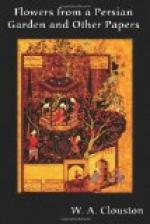Once more did a Hebrew urchin prove his superiority in wit over an Athenian: “Here, boy,” said he, “here is some money; bring us some figs and grapes.” The lad went and bought the fruit, kept half of it for himself, and gave the other half to the Athenian. “How!” cried the man, “is it the custom of this city for a messenger to take half of what he is sent to purchase?” “No,” replied the boy; “but it is our custom to speak what we mean, and to do what we are desired.” “Well, then, I did not desire thee to take half of the fruit.” “Why, what else could you mean,” rejoined the little casuist, “by saying, ‘Bring us?’ Does not that word include the hearer as well as the speaker?” The stranger, not knowing how to answer such reasoning, smiled and went his way, leaving the shrewd lad to eat his share of the fruit in peace.
“There is no rule without some exception,” as the following tale demonstrates: Rabbi Eliezar, who was as much distinguished by his greatness of mind as by the extraordinary size of his body, once paid a friendly visit to Rabbi Simon. The learned Simon received him most cordially, and filling a cup with wine handed it to him. Eliezar took it and drank it off at a draught. Another was poured out—it shared the same fate. “Brother Eliezar,” said Simon, jestingly, “rememberest thou not what the wise men have said on this subject?” “I well remember,” replied his corpulent friend, “the saying of our instructors, that people ought not to take a cup at one draught. But the wise men have not so defined their rule as to admit of no exception; and in this instance there are not less than three—the cup is small, the receiver is large, and your WINE, brother Simon, is DELICIOUS!”
TALES OF A PARROT.
I
GENERAL PLAN OF EASTERN ROMANCES—THE “TUTI NAMA,” OR PARROT-BOOK—THE FRAME-STORY—TALES: THE STOLEN IMAGES—THE WOMAN CARVED OUT OF WOOD—THE MAN WHOSE MARE WAS KICKED BY A MERCHANT’S HORSE.
Oriental romances are usually constructed on the plan of a number of tales connected by a general or leading story running throughout, like the slender thread that holds a necklace of pearls together—a familiar example of which is the Book of the Thousand and One Nights, commonly known amongst us under the title of Arabian Nights Entertainments. In some the subordinate tales are represented as being told by one or more individuals to serve a particular object, by the moral, or warning, which they are supposed to convey; as in the case of the Book of Sindibad, in which a prince is falsely accused by one of his father’s ladies, and defended by the king’s seven vazirs, or counsellors, who each in turn relate to the king two stories, the purport of which being to warn him to put no faith in the accusations of women, to which the lady replies by stories representing




